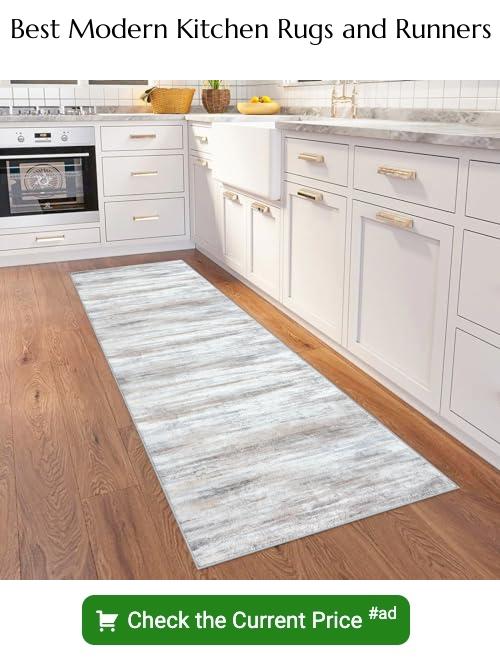Last updated on
Discover the perfect color for your kitchen floor to complement those stunning white cabinets, creating a harmonious and stylish space you’ll love.
When it comes to designing a kitchen, choosing the right color scheme can make all the difference. White cabinets have been a popular choice for many homeowners due to their timeless and versatile appeal.
However, selecting the perfect flooring color to complement your white cabinets can be quite challenging. With so many options available in the market, it’s easy to feel overwhelmed and confused.
But don’t worry! In this article, we will guide you through some of the best color options for your kitchen floor that will perfectly match with your white cabinets. So let’s dive in!
What's Inside
The Impact of White Cabinets On Flooring
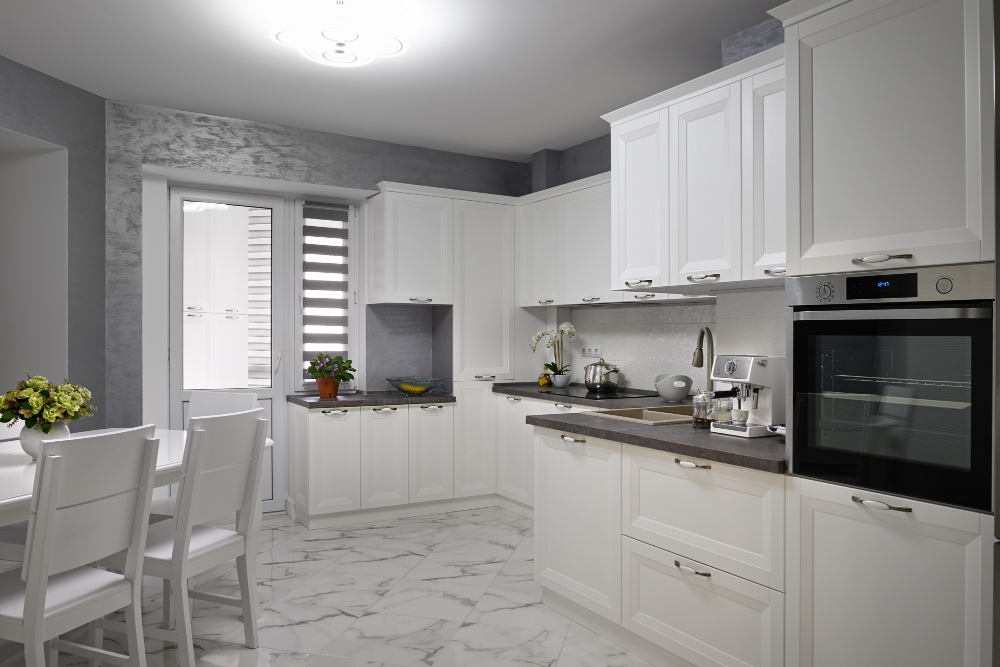
They can make your kitchen feel brighter and more spacious while also providing a neutral backdrop that allows you to experiment with different colors and textures in other areas of the room. However, when it comes to choosing the right flooring color for your white cabinets, there are some important factors you need to consider.
Firstly, white cabinets tend to dominate the visual space in your kitchen. This means that any flooring color or pattern will be competing with them for attention.
Therefore, it’s essential that you choose a floor color that complements rather than clashes with your cabinetry.
Secondly, white is an inherently bright and reflective hue which can affect how other colors appear in the room. For example, if you choose dark-colored floors such as black or espresso brown hardwoods or tiles without enough contrast between them and white cabinetry may create an unbalanced look by making everything else seem too dark compared against those bright-white cupboards.
Neutral Floor Color Options
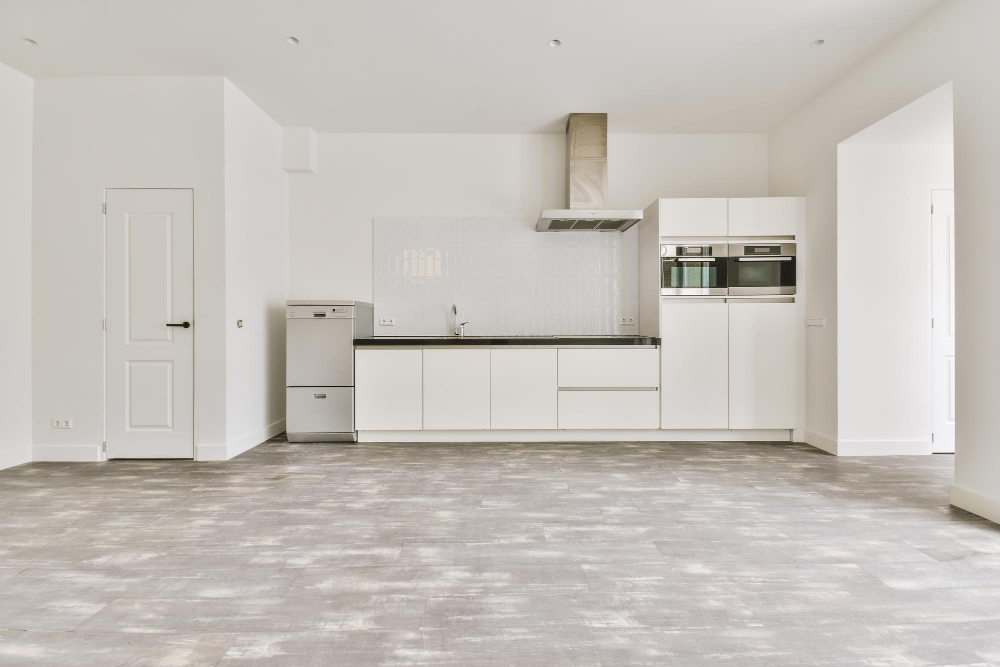
When it comes to pairing neutral floor colors with white cabinets, there are several options available in the market. One of the most popular choices is gray flooring, which complements white cabinets beautifully while adding depth and sophistication to your kitchen’s overall design.
Another great option is beige or cream-colored flooring, which creates a warm and inviting atmosphere in your space. These light-toned floors work well with both traditional and modern styles of kitchens.
If you’re looking for something more subtle yet elegant, consider opting for natural stone or concrete flooring in shades like taupe or sandstone. These earthy tones add texture to your kitchen while providing an understated backdrop that allows other elements of your design scheme to shine through.
Warm-Toned Floor Choices
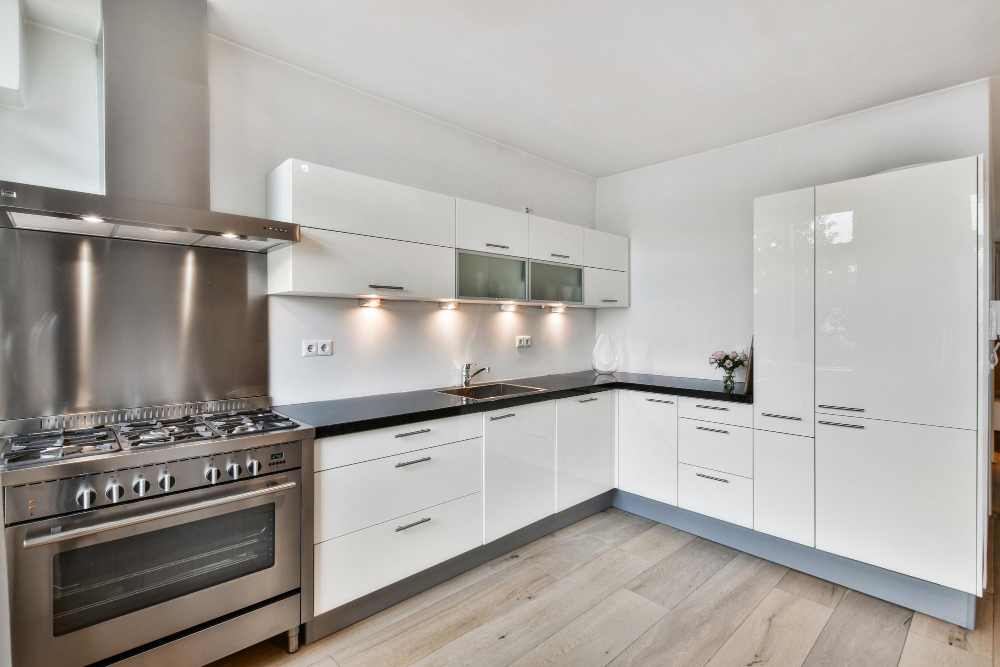
These colors can range from light beige, honey, caramel, or even reddish-brown hues. Warm tones work well with white cabinets as they create a beautiful contrast that makes the space look more vibrant and welcoming.
One of the most popular warm-toned flooring options is hardwood flooring. Natural wood floors come in various shades of brown that can complement your white cabinets perfectly.
Oakwood is one of the most common choices due to its durability and versatility in terms of color variations.
Another option for warm-tone lovers is cork flooring which has become increasingly popular over recent years due to its eco-friendliness and unique texture. Cork comes in different shades ranging from light tan all through deep browns making it easy for you to find one that matches your style preference.
If you’re looking for something more affordable than natural wood or cork but still want a similar aesthetic appeal, laminate or vinyl plank floorings are great alternatives worth considering too! They offer warmth without breaking the bank while also being durable enough not only withstand heavy foot traffic but also resist moisture damage – perfect if you have kids running around!
Cool-Toned Floor Selections
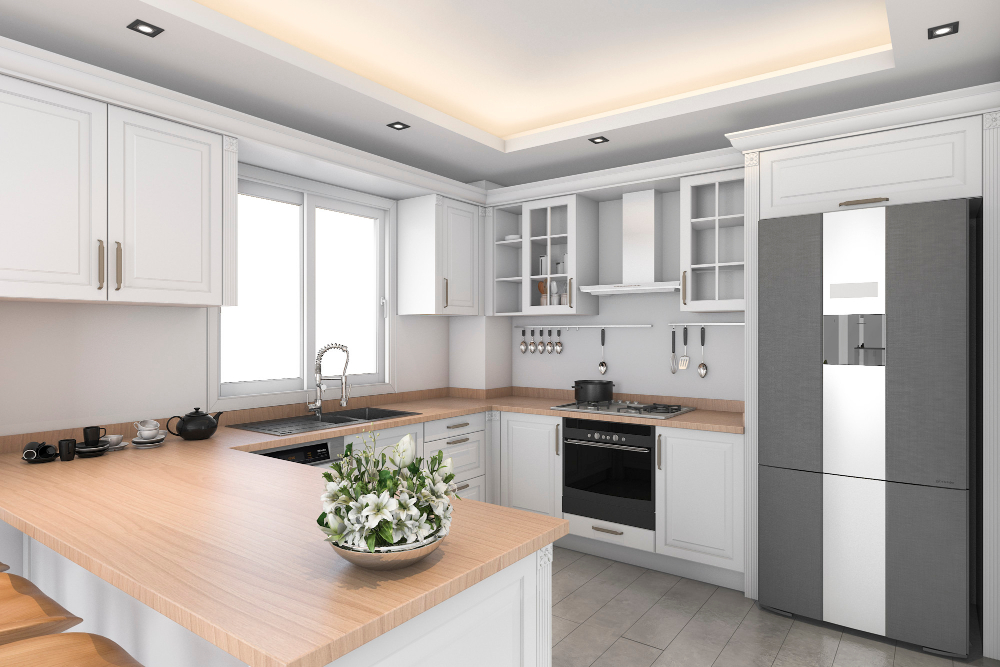
These colors work well with white cabinets, creating a fresh and modern look that is perfect for contemporary homes. Cool tones include shades of blue, green, gray, and even black.
If you’re looking for something subtle yet stylish, light gray flooring can be an ideal option. It pairs perfectly with white cabinets while adding depth to your kitchen’s overall design.
For those who prefer darker hues but still want the cool tone effect in their space – navy or slate-colored floors can add sophistication without being too overpowering.
Green is another popular cool-toned color that works well with white cabinetry; it adds freshness to the room while providing a natural feel as if bringing the outdoors inside your home! A sage-green floor paired with crisp-white cabinets creates an elegant yet cozy ambiance.
Lastly, if you’re feeling bold enough to experiment – consider black flooring! Black floors may seem intimidating at first glance but when done right they can make quite a statement piece in any kitchen design scheme by adding drama and contrast against bright-white cabinetry!
Dark Vs. Light Floor Colors
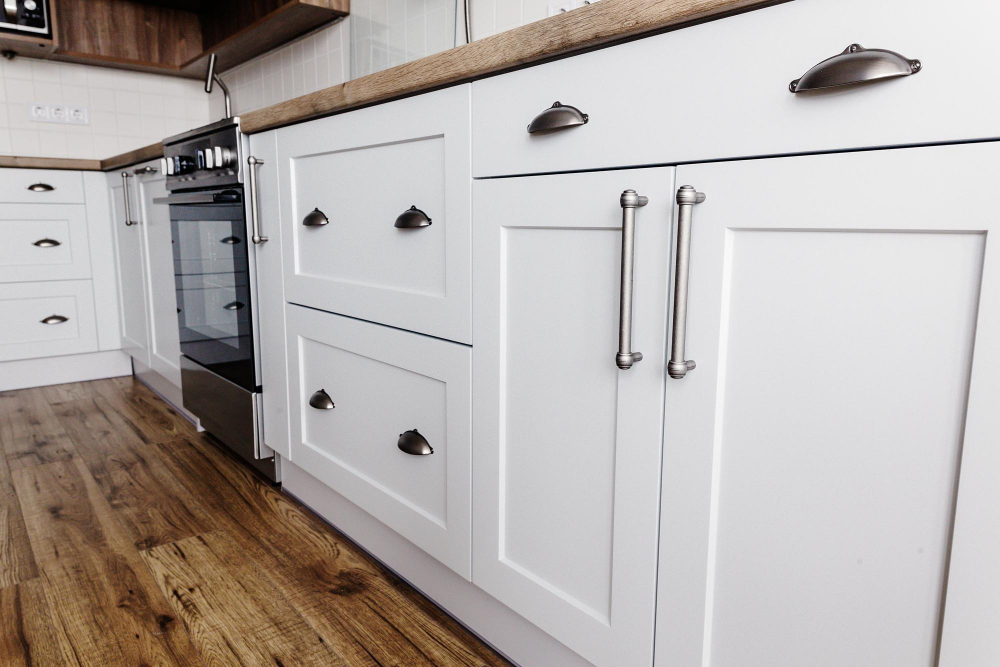
Both options have their advantages and disadvantages, so it’s essential to consider your personal preferences and lifestyle needs.
Dark floors can add depth and drama to your kitchen space while also hiding dirt and stains better than lighter shades. However, they may show scratches more easily than lighter colors, which could be a concern if you have pets or young children in the house.
On the other hand, light-colored floors can create an airy feel in your kitchen while making small spaces appear larger. They are also less likely to show scratches but may require more frequent cleaning due to visible dirt buildup.
Popular Kitchen Floor Materials
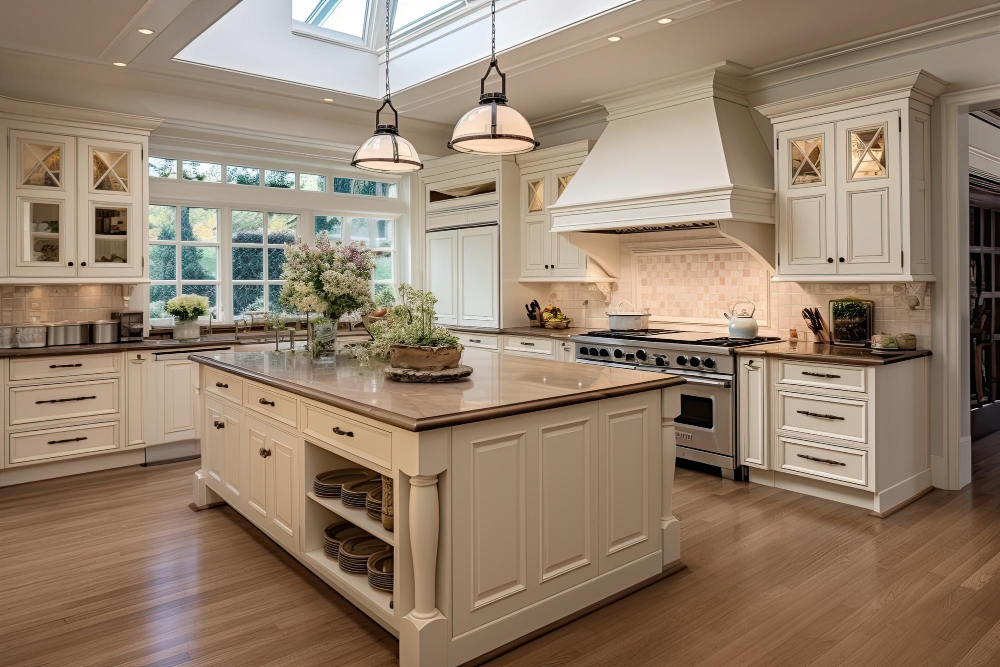
Each material has its own unique characteristics and benefits, so it’s important to consider your lifestyle and preferences before making a decision.
One of the most popular options is hardwood flooring. Natural wood floors add warmth and character to any space while also being durable enough for high-traffic areas like kitchens.
Oak, maple, cherry, and walnut are some of the most common types of hardwood used in kitchen floors.
Another classic choice is ceramic or porcelain tile flooring. These tiles come in a wide range of colors and patterns that can complement any design style from traditional to modern.
They’re also easy-to-clean surfaces that resist stains well.
For those who prefer eco-friendly options or want something more affordable than natural wood or stone tiles but still look similar; laminate planks may be an excellent option as they mimic the appearance of real wood without requiring regular maintenance like sanding or refinishing.
Natural Wood Flooring Options
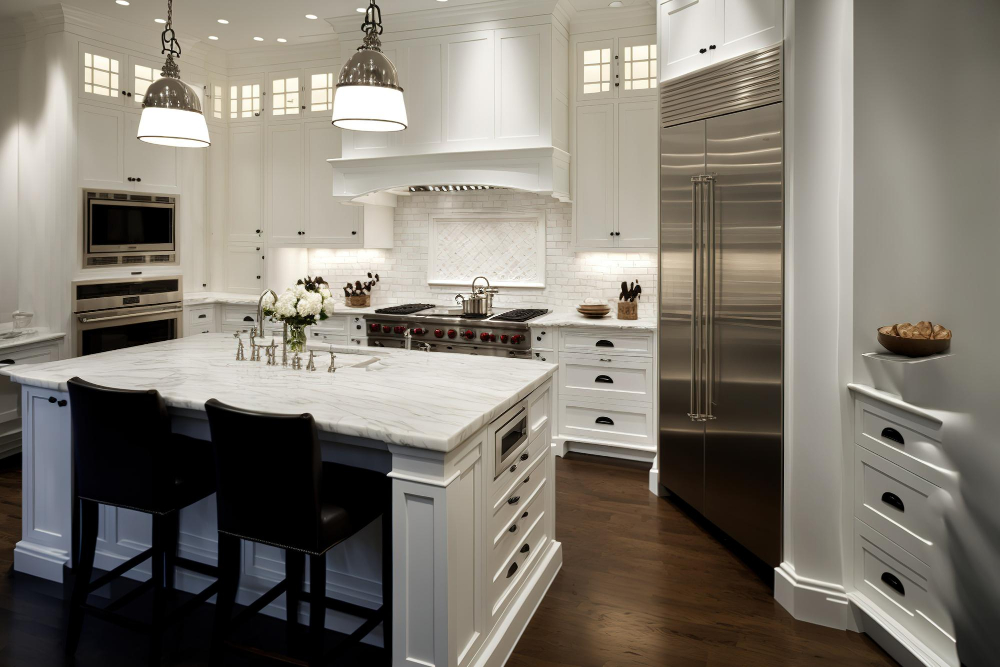
It’s also versatile enough to complement any style of white cabinets you choose. Hardwood floors are durable, long-lasting, and easy to maintain with regular cleaning and refinishing as needed.
Some popular natural wood options for kitchen flooring include oak, maple, hickory or cherry hardwoods. Oak is the most common choice due to its durability and affordability while maple offers a lighter color option that complements white cabinets well.
Hickory has more grain variation which adds visual interest while cherry provides a rich reddish-brown hue that creates an elegant look.
When selecting natural wood flooring for your kitchen with white cabinets consider the finish carefully – matte finishes hide scratches better than glossy ones but may require more maintenance over time whereas high-gloss finishes reflect light beautifully but show every scratch or dent easily.
Eco-Friendly Floor Choices
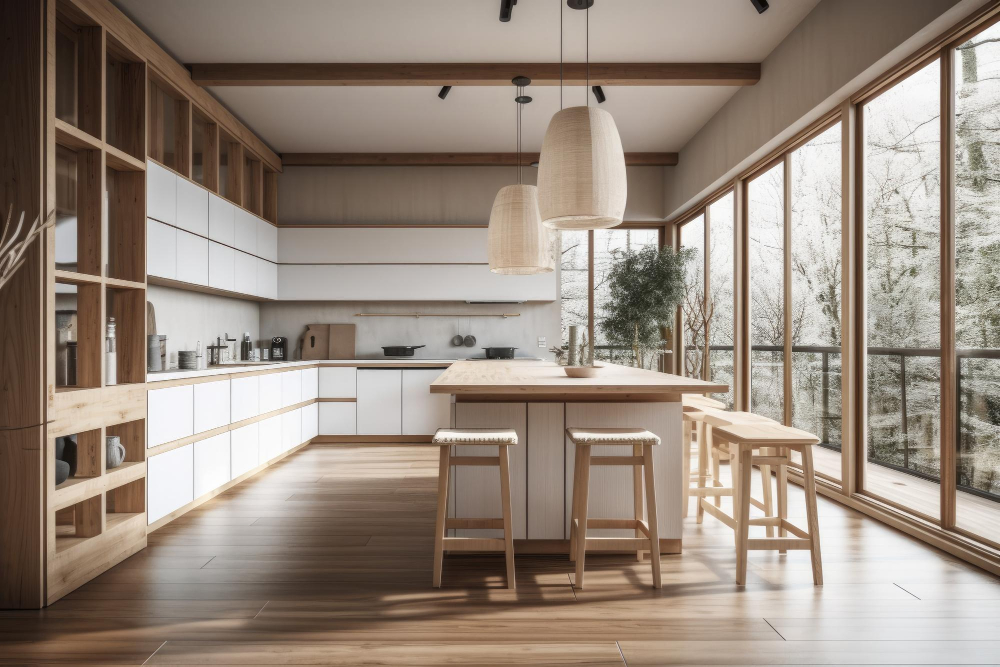
If you’re looking for an eco-friendly floor that complements your white cabinets, there are several great choices available.
Bamboo is one of the most sustainable materials for flooring. It’s fast-growing, renewable, and can be harvested without killing the plant.
Bamboo floors come in various colors and styles that can match any kitchen decor.
Cork is another excellent option as it’s made from tree bark which grows back after harvesting. Cork floors have natural insulation properties making them perfect for kitchens where standing on hard surfaces may cause discomfort over time.
Linoleum is also a green choice because it’s made from natural materials like linseed oil, cork dust, wood flour or limestone powder mixed with resins to make sheets or tiles of different sizes and thicknesses. Linoleum comes in many colors including shades of white that will complement your cabinets perfectly.
Recycled glass tile flooring has become more popular recently due to its unique look while being environmentally friendly at the same time! These tiles come in various shapes such as squares or rectangles but also hexagons giving you plenty of design options!
Pros and Cons of Tile Flooring
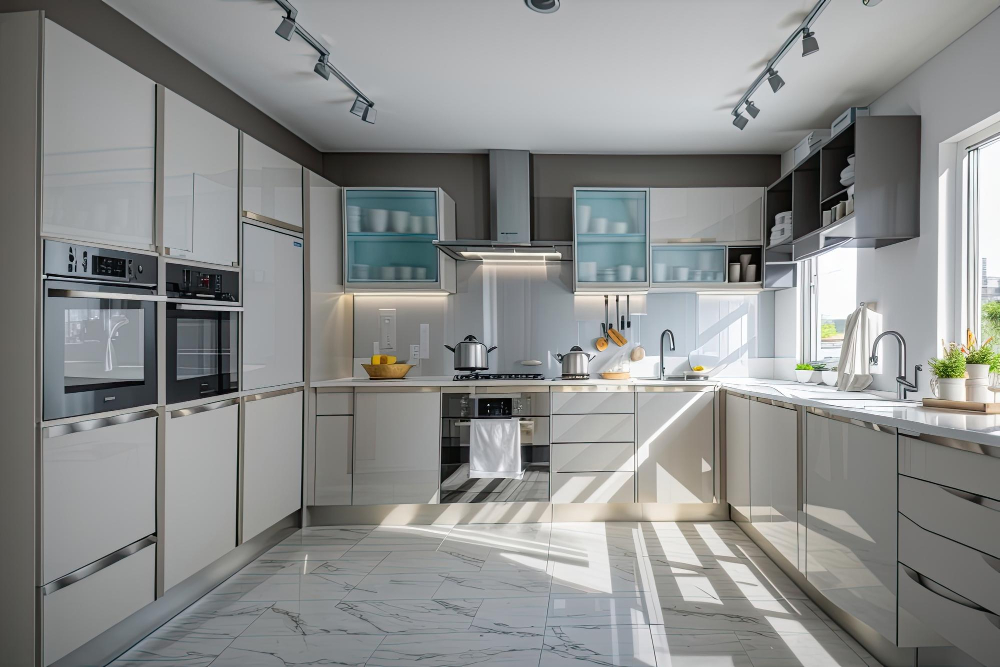
It’s essential to weigh the pros and cons before making your final decision.
Pros:
- Durability: Tile floors are incredibly durable and can withstand heavy foot traffic without showing signs of wear.
- Water Resistance: Tiles are naturally resistant to water damage, making them an excellent option for kitchen areas that frequently get wet.
- Easy Maintenance: Cleaning tile floors is relatively simple as they don’t absorb spills or stains easily. Regular sweeping or mopping will keep them looking new.
Cons:
- Hardness: Tile flooring can be hard on your feet if you spend long hours standing in the kitchen.
- Coldness: Tiles tend to retain cold temperatures which may not be ideal during winter months unless you have underfloor heating installed
- Slipperiness when Wet : Although tiles offer good traction when dry but they become slippery when wet which could lead to accidents especially with kids around
Overall tile flooring offers many benefits that make it an attractive option for homeowners who want a low-maintenance floor with high durability.
Laminate and Vinyl Floors With White Cabinets
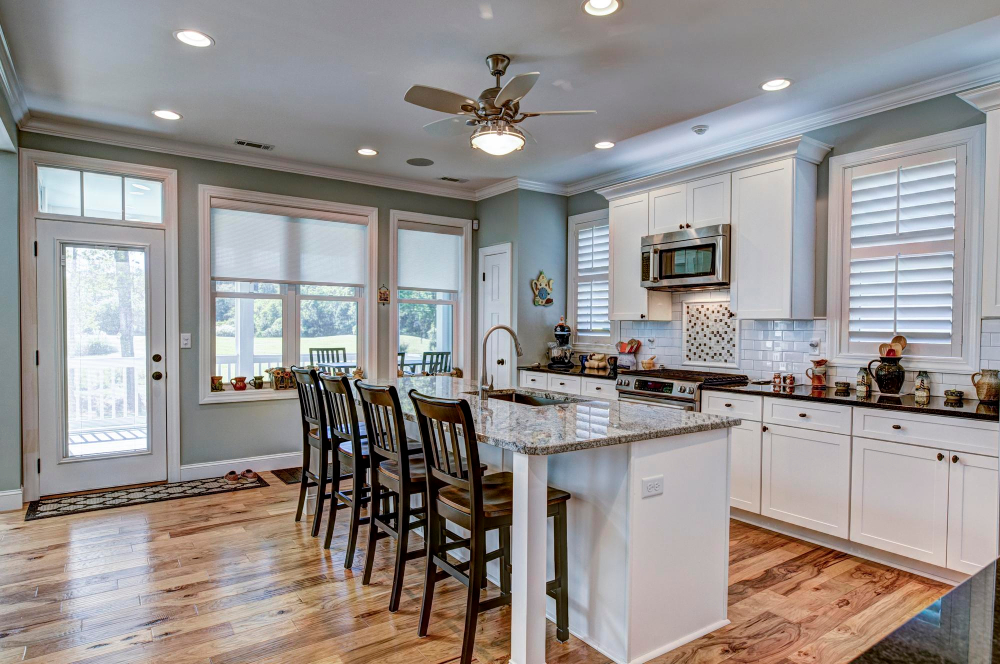
These flooring materials come in a wide range of colors, patterns, and textures that can mimic the look of natural wood or stone. When it comes to pairing laminate or vinyl floors with white cabinets, there are several options available.
For those who prefer a classic look, light-colored laminate or vinyl flooring can create an elegant contrast against white cabinets. On the other hand, dark-toned laminates or luxury vinyl planks (LVP) can add depth and warmth to your kitchen space while still maintaining its modern appeal.
One advantage of using these types of flooring materials is their durability and resistance to moisture damage – making them ideal for high-traffic areas like kitchens. They require minimal maintenance compared to natural wood floors.
When selecting laminate or vinyl floorings with white cabinets in mind; consider choosing one that has texture as this will help hide dirt better than smooth surfaces which tend show every speckle more easily.
Luxury Vinyl Tile or Plank With White Cabinets
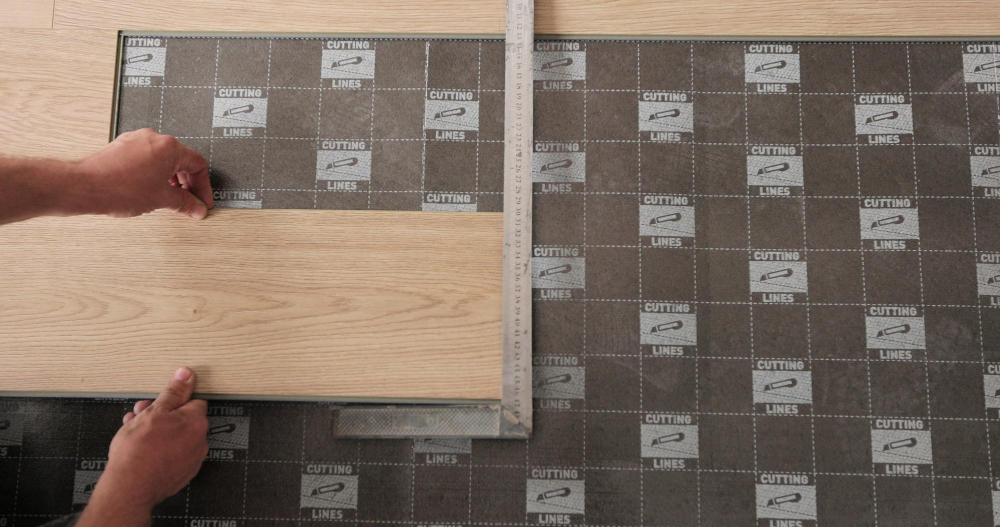
LVT/LVP comes in various colors and patterns that can mimic the look of natural materials like wood or stone. If you’re looking for a budget-friendly alternative to hardwood floors that will still complement your white cabinets beautifully, then LVT/LVP might be the perfect choice for you.
One advantage of using luxury vinyl tiles/planks with white cabinets is that they offer an excellent contrast between light and dark tones. You can choose from different shades of gray or brown to create a stunning visual effect in your kitchen space while keeping it modern and stylish.
Another benefit of using LVT/LVP with white cabinets is their low maintenance requirements compared to other flooring options such as natural wood floors. They are easy to clean, water-resistant, scratch-resistant making them ideal if you have kids or pets at home.
Complementing Your Kitchen Style
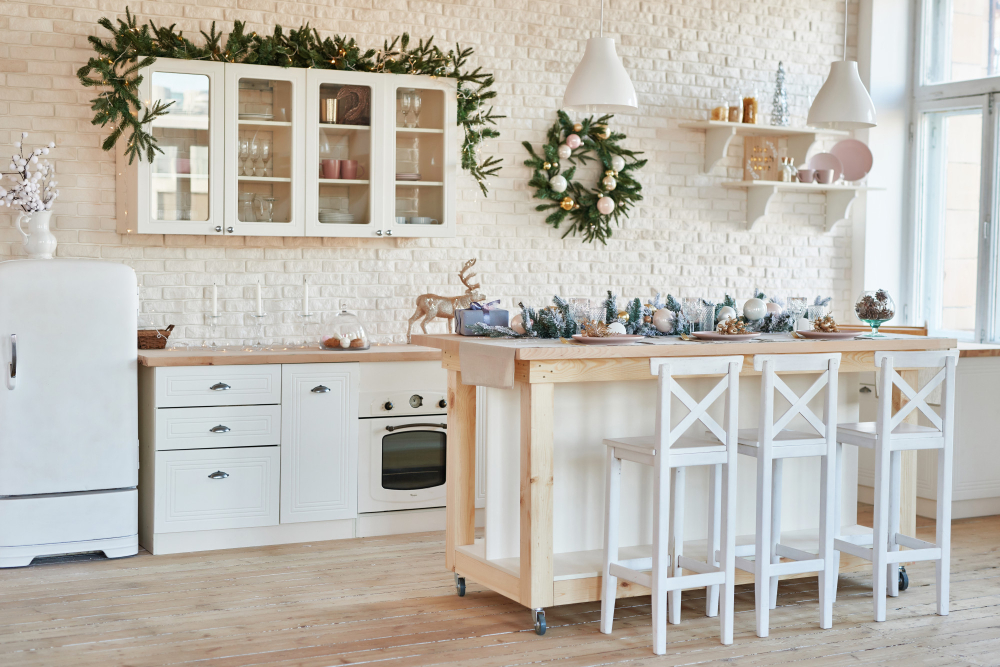
Whether you have a modern, traditional, or farmhouse-style kitchen, selecting the right flooring color can enhance its aesthetic appeal and create a cohesive look.
For instance, if you have a modern-style white cabinet with clean lines and minimalistic design elements in your kitchen space; then opting for neutral-colored floors such as beige or gray will complement this style perfectly. On the other hand, if you have an eclectic or bohemian-inspired space with colorful accents and bold patterns; then warm-toned wood floors like cherry or oak will add warmth to balance out these vibrant colors.
Similarly, if you’re going for a rustic farmhouse feel in your cooking area with shaker cabinets and vintage decor pieces; natural stone tiles like slate would be an excellent choice that complements this theme beautifully.
Emphasizing Contrast or Harmony
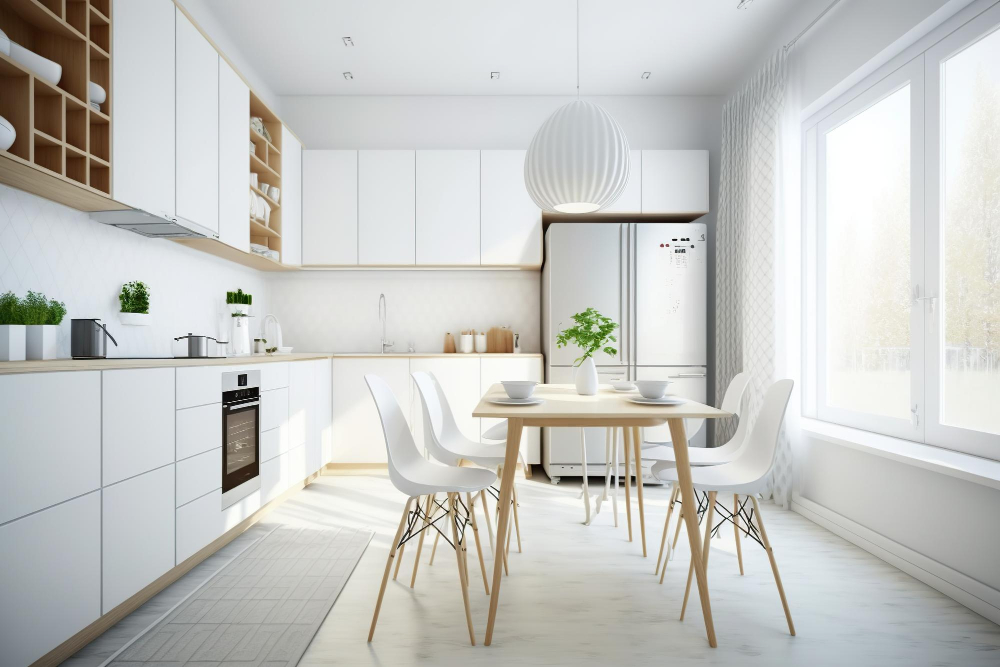
If you want to create a bold and eye-catching look, go for contrasting colors. For instance, if your white cabinets have a cool undertone like blue or gray, consider pairing them with warm-toned floors such as golden oak hardwoods or terracotta tiles.
On the other hand, if you prefer a more cohesive and calming feel in your kitchen space, opt for harmonious colors that blend well together. You can achieve this by selecting flooring materials that share similar hues with your white cabinets.
For example, pair white cabinetry with light-colored wood floors like maple or ash.
The Role of Kitchen Lighting
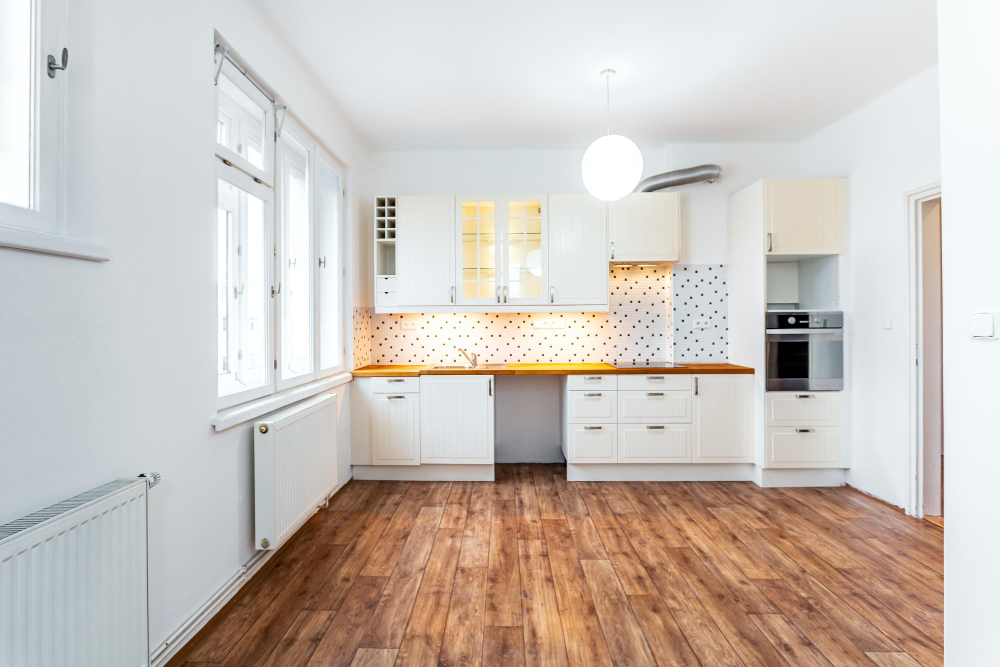
The right lighting can enhance the beauty of your white cabinets and flooring while also making your space more functional and comfortable. Proper illumination can make even small kitchens feel spacious, bright, and welcoming.
To complement white cabinets with any floor color choice you make, consider installing multiple light sources that provide different types of illumination. For example, overhead lights are great for general brightness but may not be enough to highlight specific areas or create mood lighting.
Under-cabinet lights are an excellent option for illuminating countertops while adding a warm glow to your kitchen’s overall look. Pendant lights above islands or dining tables add visual interest while providing task-specific light where needed most.
Natural light is also crucial in enhancing the beauty of both cabinet colors and flooring choices as it brings out their true tones under sunlight’s natural hues during daytime hours.
Maintenance and Durability Considerations
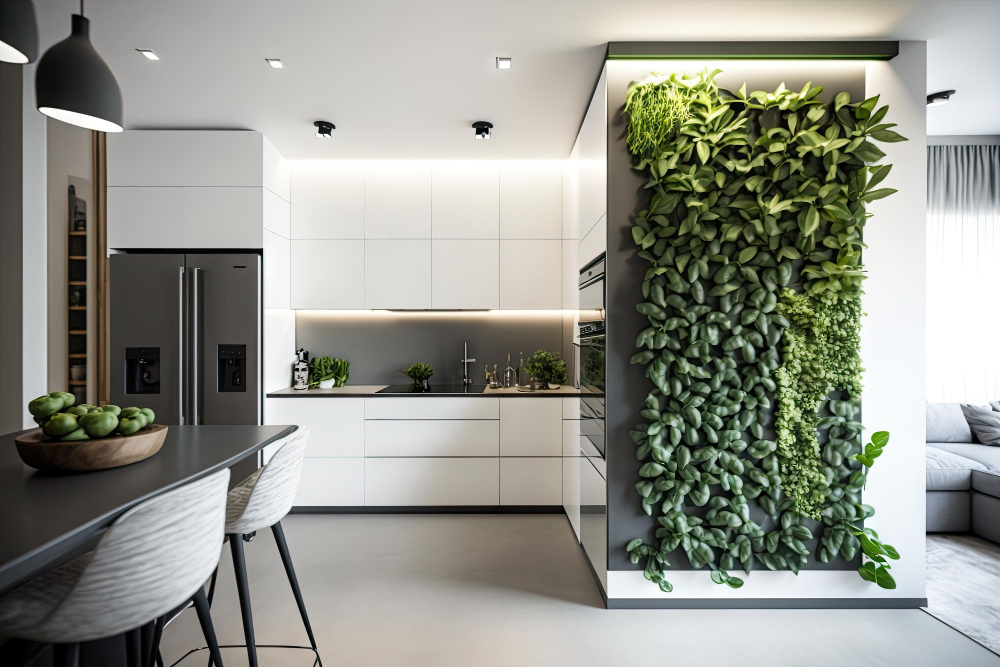
Your kitchen is a high-traffic area that requires frequent cleaning, so you want to choose a flooring material that can withstand spills, stains, and heavy foot traffic. For instance, natural wood floors are beautiful but require regular maintenance such as sanding and refinishing every few years.
On the other hand, tile floors are durable but may crack or chip if something heavy falls on them.
Laminate or vinyl flooring options offer an affordable alternative with low-maintenance requirements while still providing excellent durability against scratches and moisture damage. Luxury vinyl tile (LVT) or plank (LVP) is another popular choice due to its waterproof properties making it ideal for kitchens where spills happen frequently.
It’s also important to note that some floor colors may show dirt more easily than others; therefore lighter shades might require more frequent cleaning than darker ones.
Making Your Floor Last Longer

Proper maintenance can help extend the life of your flooring and keep it looking new for years to come. Here are some tips on how to make your kitchen floor last longer:
1. Clean up spills immediately: Spills can cause stains or damage if left unattended, so be sure to clean them up as soon as possible.
2. Use mats or rugs: Placing mats or rugs in high-traffic areas such as near sinks and stoves can protect your flooring from scratches, dents, and other types of wear.
3. Sweep regularly: Dirt particles that accumulate on the surface of a floor may scratch its finish over time; therefore sweeping regularly is important.
4. Avoid harsh chemicals: Some cleaning products contain harsh chemicals that could damage certain types of floors; always read labels before using any product on a new type of flooring.
5. Trim pet nails frequently – If you have pets at home with long nails then trim their nails frequently because they might scratch off the surface layer while running around in excitement.
Examples of Stunning Kitchen Floors

Here are a few ideas to inspire you:
1. Gray-toned hardwood flooring: A gray-toned hardwood floor is an excellent choice if you want a neutral look that’s not too light or dark.
It pairs beautifully with white cabinets and adds warmth and texture.
2. Black-and-white checkered tile: If you’re looking for something bold and eye-catching, consider black-and-white checkered tile flooring.
This classic pattern has been around for decades but remains popular today because it looks so striking in any space.
3. Light-colored stone tiles: Light-colored stone tiles like travertine or limestone can add elegance and sophistication to your kitchen while complementing the clean lines of white cabinetry.
4.Wide-plank natural wood floors: Wide-plank natural wood floors are perfect if you want a rustic or farmhouse-style look in your kitchen space while keeping things bright by pairing them with white cabinets.
5.Patterned ceramic tiles : Patterned ceramic tiles come in various colors, shapes, sizes & designs making them versatile enough to match any style preference from traditional to modern kitchens.
Expert Opinions On Floor Colors
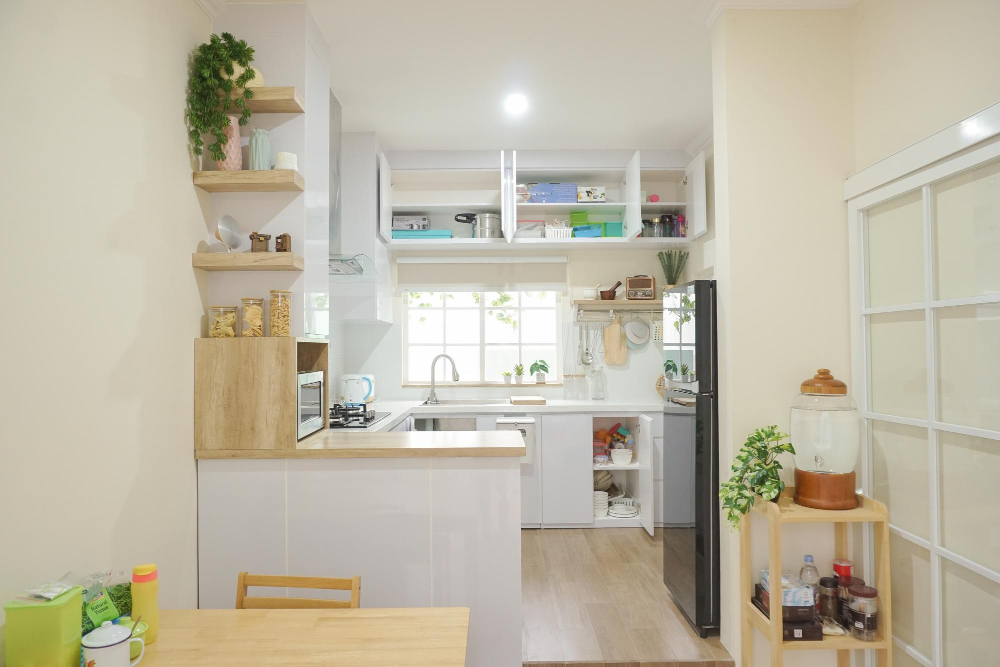
According to them, neutral colors like beige and gray are always a safe bet when it comes to flooring with white cabinets. These shades create an elegant and timeless look that will never go out of style.
However, if you want something more daring or unique, you can opt for warm-toned floors like honey-colored hardwood or terracotta tiles. These hues add warmth and depth to your space while still complementing the crispness of white cabinets.
On the other hand, cool-toned floors such as light blue-gray tiles or pale green vinyl planks can create a refreshing contrast against white cabinetry while maintaining an overall cohesive look in your kitchen.
Ultimately though, it all depends on personal preference and what works best with your specific kitchen style.
FAQ
What floor looks best with white kitchen cabinets?
The best floor for white kitchen cabinets is dark-stained wood, as it provides a beautiful contrast and incorporates a natural feel, while ceramic tile is also a suitable option for a seamless look.
Should flooring be lighter or darker than cabinets?
Flooring can be either lighter or darker than cabinets, but it is generally recommended to use darker floors with light cabinetry and vice versa for a balanced contrast.
Do dark floors go with white cabinets?
Yes, dark floors go well with white cabinets, creating a high-impact design that works especially well in rooms with light challenges.
What is a good color for kitchen floor?
A good color for a kitchen floor is white or yellow, as they create a light and airy ambiance, making the space feel more relaxed.
How do different floor materials complement white kitchen cabinets?
Various floor materials such as hardwood, natural stone, and colorful tiles can complement white kitchen cabinets by creating a warm, elegant, or vibrant aesthetic, respectively, enhancing the overall kitchen design.
How can you create contrast in a kitchen with white cabinets and colorful floor options?
To create contrast in a kitchen with white cabinets and colorful floor options, consider utilizing bold floor patterns or colors, contrasting textures, and coordinating accents like backsplash or countertops.
How can one’s choice of kitchen floor color impact the overall aesthetic of a space featuring white cabinets?
One’s choice of kitchen floor color can impact the overall aesthetic of a space featuring white cabinets by either complementing, contrasting, or blending with the cabinets, creating a harmonious and visually appealing environment.
